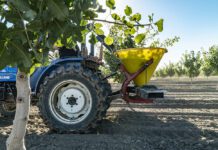
If anyone has an inside view of California’s tree-nut industry, it’s Jim Zion.
Zion is the managing partner of Meridian Growers, a growing and processing company that sells some 25 million pounds of dried fruits and nuts to 40 countries each year.
He’s been involved with California agriculture, particularly pistachios, for more than 20 years. Earlier in his career, he worked as an agricultural appraiser with Security Pacific Bank. He later managed the California Agricultural Export Program for the California Department of Food and Agriculture.
Today, he’s vice chairman on the board of directors of American Pistachio Growers. He’s also on the board of the Specialty Crop Trade Council, which negotiates ocean freight rates on behalf of the industry.
Meridian Growers processes its pistachios at its plant, built in 2021, near Firebaugh, Calif. Zion and his team are already increasing its capacity, which will expand Meridian Growers’ pistachio volume to 50 million pounds this year.
Almonds from Meridian Growers’ orchards head to Minturn Nut Company for processing. Its pecans are handled by Texas-based Southern Roots Nut Company, which Meridian recently joined, partly because Zion likes its cooperative pooling mode.
Zion’s experiences give him unique insight into both domestic and international markets. They’ve earned him a few battle scars too, including “gray hair and ulcers” brought about, he said, by the supply-chain disruptions that wracked California ag exporters when the COVID-19 pandemic hit in 2020.
In late August, he discussed his views with West Coast Nut on the challenges and opportunities for California pistachios and almonds.

Q. What’s the pistachio market looking like?
Pistachios remain a strong market, with good demand for new crop coming out of China and, to a certain point, India. We expect European buyers to come back into the marketplace in early September. We’re seeing some demand out of Canada. Our domestic markets have been stable. I’m happy with what we’re seeing so far.
Q. What are ballpark prices for pistachios right now (late August)?
Even though it’s a larger crop this year, we have a very minimal carry-in from last year. A lot of the crop was sold or has been committed, so pistachios are a pretty stable marketplace. On the bulk wholesale level, prices are about $3.65 a pound for in-shell #21, which is the Chevrolet or standard of pistachios. In terms of the commodities that we work with, pistachios are still doing well.

Q. What’s your view of the almond market?
There’s the large carryover from last year, which has depressed the market. The official estimate for this year’s crop is 2.6 billion pounds, but most growers don’t think it’s going to reach that. In our own orchards, we’re down 25% from last year, and we were down the year previously. But we’ve recently seen the market start to move again, mainly on strong demand coming out of India for in-shell. We’re getting more inquiries from Southeast Asia. What I’ve found is when almond prices go down, people start looking to buy more. When that happens, we see demand go up as people look at incorporating almonds more. So, I do think we’re going to see prices level out and start to move up, especially if the crop ends up being less than 2.6 billion.
Q. Are you pulling out almond trees?
No. We like to be multi-faceted, never a single commodity, because you never know what’s going to happen. It’s rare that all the commodities move up or down at the same rate. Plus, for marketing, it’s better for us because we can go to a customer and have multiple products for them. Some of the small to mid-sized customers like to make one phone call to inquire about almonds, pistachios and other products.

Q. What’s the solution for the burdensome supply of almonds?
Almonds are going to be self-regulating. Orchards are coming out. Some are the older orchards that aren’t efficient, and some are the younger ones that may not have adequate water. The cost of production has gotten so high. So, you’ll see the supply situation start to move down, and then you’ll see prices come up. You may see some additional plantings, but there will be a limit. With interest rates approaching 10%, development costs are pretty high. Unless you have a decent return back, which almonds don’t at this point, I don’t see a big rush to plant trees.
I just hope we don’t get into an under-supply situation and not have enough product because the last thing we want is not to have an adequate supply to keep this demand going.

Q. What are your biggest challenges?
The biggest issue in California is water. We know SGMA (Sustainable Groundwater Management Act) is going to be implemented. A lot of growers know there will be a reduction in water, but they’re not sure how it’s going to affect them. Most everybody is looking to make sure they have at least two sources of water.
Beyond the water situation, it’s the rules and regulations we have to follow in California. Every year, they get more onerous. On the processing side, we expect minimum wages to go up. We’re hearing rumors they may increase to $25 an hour. The cost of labor is getting more expensive. So, anything we can do to become more efficient or automated, we’re going to do. That’s just a fact of life for us to survive.
Q. What are your thoughts on the heavy pistachio production expected in the next couple of years?
The increased plantings we saw four, five, six years ago will start coming in. So, we know the 2-billion-pound crop is coming. A lot of effort in the industry, both generic and branded, is toward building demand ahead of supply. It’s getting consumers to realize that pistachios are a healthy part of their diet, one of the only nuts that are 100% protein. It has all 13 amino acids. The more we push that health message, the more it will help.
In addition, we’re looking at other uses for pistachios. Most people still eat them as a snack with the shell on them. But you’re seeing more and more people use pistachios as an ingredient. More restaurants are incorporating pistachios. We went to a restaurant the other day and had a caprese salad that had pistachios all around it. That’s how we can move that demand-curve up. Our goal is to always pull that demand ahead of supply so we’re not surprised.
Q. What’s ahead in the export market?
The big market for many years was China because of its population and growth. But we are seeing changes in China. Their economy is slowing down, unemployment is going up and interest rates are rising. We don’t have the best trade relations with China, and I don’t see that getting any better in the near future. I hope we can maintain the status quo because Chinese consumers like dried fruits and nuts.
The next one coming up is India, the most populous country in the world. They’ve got a burgeoning middle class that’s expanding rapidly. Nuts are a very important part of their diet. India is going to be one of the most important markets for pistachios. It already is for almonds. Europe is a more mature market, so the growth there is going to have to be on new products. There’s some interest from Mexico and some pockets of growth we could see in Africa.
Q. What else is Meridian Growers working on?
We’re always looking to improve our processing automation to make things more efficient, to recover more of the product and return more dollars back to the growers. My son, Tyler, is working with me now. He’s starting to work on value-added products. His big project right now is pistachio butter. In Europe, they use pistachios on everything. In Spain, they take pistachio butter and make it into gelato. Pistachio butter is amazing and has a unique color. There’s no other nut out there that’s going to be green. When you make a fresh-ground pistachio butter, the flavor is absolutely amazing. I see value-added as the future for pistachios.
Q. What’s your outlook for this new marketing year?
We’re expecting good crops in California on almost everything. So, we’re going to have to work on the marketing side. With the world economy and all the uncertainty, it’s once again getting back to the basics of why a consumer would want to spend that dollar, euro, yen, whatever it is, on that pound or kilo of nuts. What’s the value proposition? That’s highly important. And I think you’re going to see more messaging on farmers as environmentalists. I mean, we’re the original ones. We’ve been doing it for years. We rely on clean soil, water, air, you name it. We have to. The trees we manage are going to become more important as we work toward whatever that goal is on climate change and trying to reduce emissions. California and Arizona agriculture will be a key part of that.











